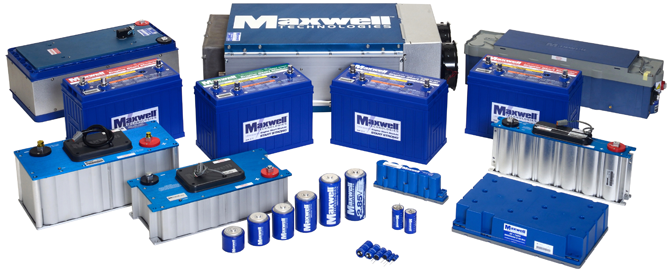Ultracapacitors and supercapacitors, those mass-energy storage components have been around for a while. With values in the hundreds of Farads – at one time 1,000 µF was considered substantial – they find employment in a plethora of applications, most of which involve power storage. Just a mechanical note here, ultra and super capacitors are synonymous, they are one and the same.
Over the past several years, supercaps have been growing in capacity, exceeding 1,000 Farads, extending voltage ratings, while also coming down in size. One of the things that somewhat limited their use was their inherently low voltage handling capability. Lower cap values are capable of higher dc-voltage ratings. For example, you can get a 20-µF electrolytic with a 450V or 500V rating, but early ultracaps could pack 20F with a 3V rating.

An array of Maxwell ultracapacitors
The other aspect that limited ultracap usage was price. Although all would benefit, most designs did not warrant the more expensive component. However, as always, with time and development, the prices of supercaps is coming down.
A groundbreaking development is General Motors’ recent announcement that it will be the first US automotive OEM to use ultracapacitors for start-stop applications. To be exact, an Automotive Systems' Maxwell-powered voltage stabilization system (VSS) will be a standard feature on 2016 Cadillac ATS and CTS sedans and ATS coupes, excluding the ATS-V, CTS-V and CT6 models. As per General Motors, using the Continental ultracapacitor-based voltage stabilization as part of the enhanced start-stop system will lower fuel costs, improve performance, and reduce emissions while enabling a superior owner-driver experience.
In start-stop systems, the internal combustion engine is shut off when the driver stops and the engine is seamlessly restarted when the driver accelerates. Battery-based start-stop systems augmented with an ultracapacitor-based voltage stabilization system provide burst power needed to restart the engine, reducing high currents and repeated cycling that can shorten battery life. The voltage stabilization electronic control results in a smooth start, reduced engine vibration, and possibly lower maintenance costs.
For comparison, batteries store energy via chemical reaction while ultracapacitors store energy in an electric field. This allows ultracapacitors to charge and discharge in fractions of a second, perform normally over a broad temperature range, operate reliably through one million or more charge/discharge cycles, and resist shock and vibration.
For more information, visit http://www.maxwell.com/solutions/transportation/auto/start-stop-micro-hybrid